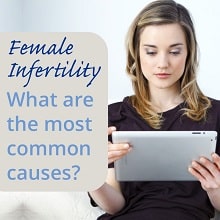
By Dr Vadim Mirmilstein, City Fertility Centre Melbourne.
It is estimated that about 30 per cent of infertility can be attributed to a female issue. These problems can develop from a range of factors, many of which are treatable. Therefore, the first and most important step, where possible, is to determine the cause of the fertility issues.
Diagnosing the cause of infertility in females is done through a range of means, including consultation with a fertility specialist, blood tests, pelvic ultrasound or X-ray, and sometimes laparoscopy (keyhole surgery).
For females the most common causes of infertility include:
Causes
Medical conditions
- Polycystic Ovarian Syndrome (PCOS): A condition where the ovaries secrete abnormally high amounts of androgens (male hormones) that often cause problems with ovulation. Women with PCOS have enlarged ovaries that contain multiple, small cysts.
- Endometriosis: Endometriosis results when endometrial-like cells (cells from inside the uterus) grow outside the uterus. Distortion of the anatomy due to endometriosis can block or change the function of the fallopian tubes and prevent the sperm from reaching and fertilising the egg.
- Fibroids: These non-cancerous masses are found in the uterus or cervix. Uterine fibroids are found in one out of every four or five women in their 30s and 40s. Fibroids can cause tubal blockages, prevent the embryo from attaching to the uterine wall and cause miscarriage. The impact the fibroids have on fertility depends upon their size and location.
- Blocked fallopian tubes
- Premature menopause: Premature Ovarian Failure (POF) is also called early menopause. This term refers to a condition whereby the ovary stops ovulating earlier than is normal. The average age range for menopause is between 45 and 55.
- Other medical causes: Thyroid disorders and genetic conditions.
Age
A woman’s age is a significant factor and often the most important indicator of her chance of conceiving. Conception rates for normal healthy couples are, at best, 20-25% per menstrual cycle. Once a woman reaches the age of 35, her fertility begins to decline. By age 40, it is estimated that her conception rate is in the range of 8-10% per month and at age 43, the pregnancy rate is thought to be as low as 1-3% per month. In addition to a reduction in pregnancy rates associated with increasing female age, there is also a significant rise in the risk of miscarriage and chromosomal (genetic) abnormalities.
Irregular menstrual cycles
Irregular cycles may suggest a problem with ovulation. The average length of the menstrual cycle is 28 days, but can range from 25-35 days. The cycle is determined by a complex interaction of hormones, so any hormone imbalance can make your period irregular. Although, in most cases, irregular cycles are not dangerous, it is important to determine the cause.
Unexplained infertility
It is estimated that about 10% of infertility remains unexplained even after complete medical evaluation.
Treatments
Once the cause of female infertility has been determined, a treatment plan can be devised.
At City Fertility Centre we will always start with the most “natural” or least-invasive treatment suitable for the situation. In fact, two-thirds of City Fertility Centre patients are helped with treatments that do not require them to proceed to IVF.
Treatment options for female infertility include:
Ovulation Induction
This involves the use of medication (Clomid or follicle stimulating hormone) to stimulate the ovaries and encourage or regulate ovulation. Ovulation induction is often combined with Intra-Uterine Insemination – a procedure in which sperm is inserted directly into a woman’s uterus in an effort to improve the likelihood of fertilisation.
Surgery
For women, surgery can often improve their chances of conception when the cause of infertility can be traced to past inflammation or infections that have created scarring, or conditions such as fibroids, endometriosis and other tubal or uterine issues.
In Vitro Fertilisation (IVF)
IVF is used to treat infertility that has failed to respond to other medical or surgical interventions. IVF involves the fertilisation of the egg by the sperm in an incubator outside the body, and transfer of the embryo back into the uterus.
While infertility can be a challenging experience for you and your partner, the good news is that it can usually be treated.
For more information on female infertility, visit our page: Female Infertility Diagnosis
Image courtesy of Shutterstock.com















